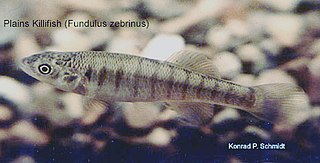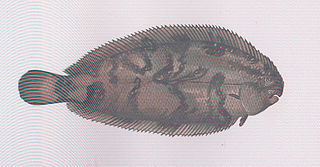
A flatfish is a member of the ray-finned demersal fish order Pleuronectiformes, also called the Heterosomata, sometimes classified as a suborder of Perciformes. In many species, both eyes lie on one side of the head, one or the other migrating through or around the head during development. Some species face their left sides upward, some face their right sides upward, and others face either side upward.

The true soles are a family, Soleidae, of flatfishes. It includes saltwater and brackish water species in the East Atlantic, Indian Ocean, and West and Central Pacific Ocean. Freshwater species are found in Africa, southern Asia, New Guinea, and Australia.

The Scophthalmidae are a family of flatfish found in the North Atlantic Ocean, Baltic Sea, Mediterranean Sea, and Black Sea. Fish of this family are known commonly as turbots, though this name can refer specifically to Scophthalmus maximus, as well. Some common names found in species of this family are turbots, windowpanes, and brills.

Pelagic fish live in the pelagic zone of ocean or lake waters—being neither close to the bottom nor near the shore—in contrast with demersal fish that do live on or near the bottom, and reef fish that are associated with coral reefs.

Demersal fish, also known as groundfish, live and feed on or near the bottom of seas or lakes. They occupy the sea floors and lake beds, which usually consist of mud, sand, gravel or rocks. In coastal waters they are found on or near the continental shelf, and in deep waters they are found on or near the continental slope or along the continental rise. They are not generally found in the deepest waters, such as abyssal depths or on the abyssal plain, but they can be found around seamounts and islands. The word demersal comes from the Latin demergere, which means to sink.

Sole is a fish belonging to several families. Generally speaking, they are members of the family Soleidae, but, outside Europe, the name sole is also applied to various other similar flatfish, especially other members of the sole suborder Soleoidei as well as members of the flounder family. In European cookery, there are several species which may be considered true soles, but the common or Dover sole Solea solea, often simply called the sole, is the most esteemed and most widely available.

The common sole, Dover sole, or black sole is a species of flatfish in the family Soleidae. It is one of the largest fish in the Solea genus. It lives on the sandy or muddy seabed of the northern Atlantic and the Mediterranean Sea where it often semi-immerses itself in the substrate. The upper side is greyish-brown while the underside is white. It grows to a maximum length of about 70 cm (28 in). The species is prized as a food fish, being caught mostly by trawling on the seabed.

Samaridae is a family of crested flounders, small flatfishes native to the Indo-Pacific. The family contains four genera with a total of 29 species.

A bottom feeder is an aquatic animal that feeds on or near the bottom of a body of water. Biologists often use the terms benthos—particularly for invertebrates such as shellfish, crabs, crayfish, sea anemones, starfish, snails, bristleworms and sea cucumbers—and benthivore or benthivorous, for fish and invertebrates that feed on material from the bottom. However the term benthos includes all aquatic life that lives on or near the bottom, which means it also includes non-animals, such as plants and algae. Biologists also use specific terms that refer to bottom feeding fish, such as demersal fish, groundfish, benthic fish and benthopelagic fish. Examples of bottom feeding fish species groups are flatfish, eels, cod, haddock, bass, grouper, carp, bream (snapper) and some species of catfish and shark.

The solenette or yellow sole, Buglossidium luteum, is a species of flatfish in the family Soleidae, and the only member of its genus. It is characterized by its small size, low-slung semi-circular mouth, and regularly placed dark fin rays. A common and widespread species, it is native to sandy bottoms in the northeastern Atlantic Ocean and the Mediterranean Sea. It is of little commercial value.

The Pacific sand sole, also known as simply sand sole, is a flatfish species inhabiting the northeastern Pacific waters where it lives on sandy bottoms. The only species in the genus, Psettichthys, it ranges from the Bering Sea to Northern California.

The butter sole is an edible flatfish of the family Pleuronectidae. It is a demersal fish that lives on soft, silty bottoms in temperate waters at depths between 20 and 425 m. Its native habitat is the northeastern Pacific, from the Bering Sea and the Aleutian Islands, along the coasts of Alaska, Canada, and the USA as far south as Ventura, California. It grows up to 55 cm (22 in) in length, and can live for up to 11 years.

The wedge sole, is a flatfish of the family Soleidae. It is a bottom dwelling predatory fish inhabiting both sandy and muddy soils at depths between 10 and 450 m in the East Atlantic and Mediterranean Sea. It achieves a maximum size of 30 cm (12 in).

Fundulus zebrinus is a species of fish in the Fundulidae known by the common name plains killifish. It is native to North America, where it is distributed throughout the Mississippi River, Colorado River, and Rio Grande drainages, and other river systems; many of its occurrences represent happy introduced populations.

The Egyptian sole is a species of flatfish in the true sole family, Soleidae. It lives on the sandy or muddy seabed of the Mediterranean Sea, and is now colonising the Red Sea. It often semi-immerses itself in the substrate. The upper side is greyish-brown while the underside is white. It grows to a maximum length of about 70 cm (28 in). This fish is used for human consumption and is prized as a food fish. It is caught mostly by trawling on the seabed.

The ovate sole is a species of flatfish in the true sole family, Soleidae native to the Indo-Pacific. Solea ovata has eyes on the right side with small scales on the sides of its body (ovata). The total length of its mitogenome is 16,782 bp with 13 protein-coding genes, 22 tRNA genes, and 2 rRNA genes. The organism, Solea Ovata was found in Guangdong province, China. Solea Ovata are usually found in shallow sand and mud at the bottom of water throughout the coast of Indo-Pacific ocean.

Solea senegalensis, the Senegalese sole, is a species of flatfish from the family of the true soles, the Soleidae, from the eastern Atlantic and the Mediterranean Sea.

The thickback sole, also known as the bastard sole and lucky sole, is a species of flatfish from the family of true soles, the Soleidae. It is found in the eastern Atlantic Ocean and the Mediterranean Sea, it is a quarry for fisheries in the Mediterranean.

Girella zebra, also known as zebrafish or stripey bream, is a species of marine ray-finned fish, a sea chub in the family Kyphosidae. It lives in the Indo-Pacific, where it is endemic to the coastal waters of the southern parts of Australia.
Zebrias zebrinus is a ray-finned flatfish and member of the family Soleidae.


















